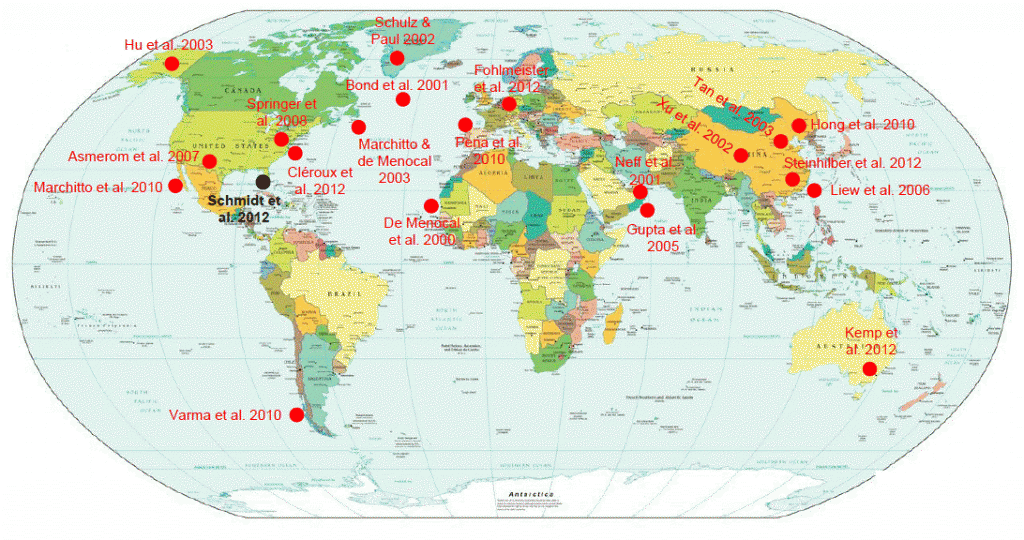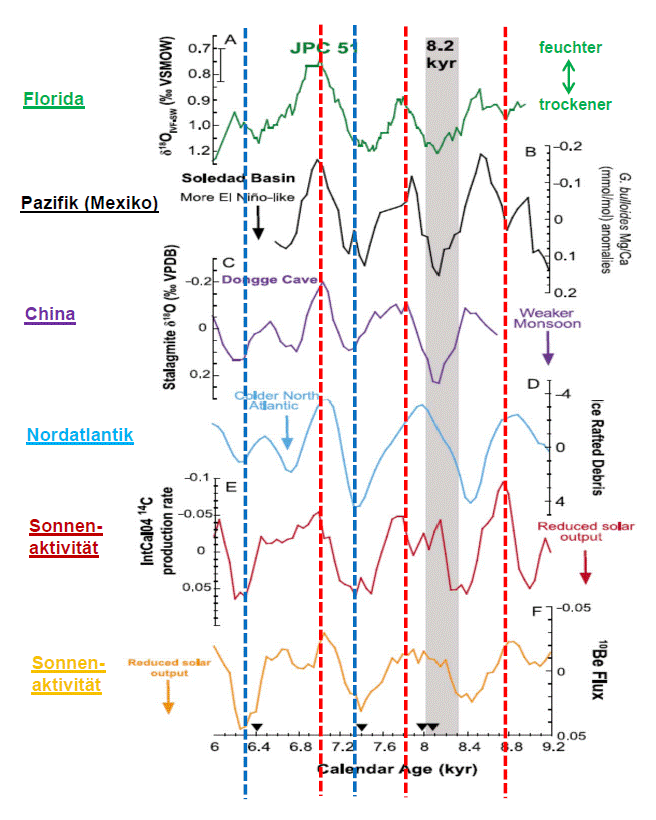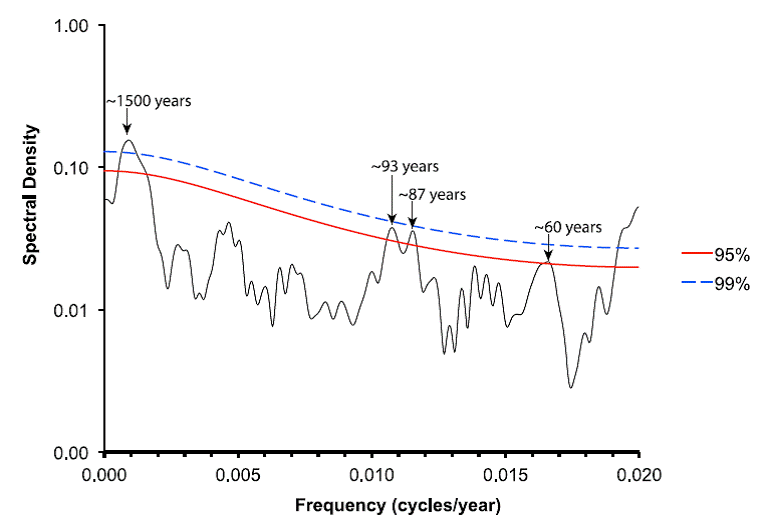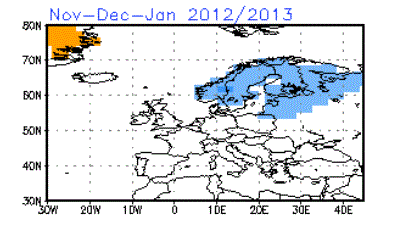By Dr. Sebastian Lüning
(Translated/edited by P Gosselin)
The climate of the last 10,000 years has not been as stable as leading IPCC scientists assume. Over the last 10 years there has been a flurry of papers from studies conducted all over the world (Figure 1) and they reveal cyclic fluctuations of the climate on a 1000-year scale. The climate changes are synchronous with solar activity, which indicates that the sun is the main driver behind climate change. The same can be said about the climate over the last 1000 years, and for the recent warming of the 20th century.

Figure 1: Overview of literature on solar activity and global millennial cycles. Black dot indicates the location of Matthew Schmidt’s area of studay of his recent publication.
The newest publication appeared in the journal Paleoceanography in July, 2012. A team of scientists led by Matthew Schmidt of Texas A&M University studied a sediment core taken 200 meters below the sea surface in the Florida Strait. The core covers the last 10,0000 years of climate (see black dot in Figure 1). The Gulf Stream passes through this narrow strait on its way north, thus making it an important connecting link between the tropics and the high Atlantic latitudes.
It’s been long known that the climate history of the Florida Strait is closely coupled with the climate development of the high Atlantic latitudes. As temperatures in the North Atlantic plummeted during the Little Ice Age, the Florida region became much drier.
Matthew Schmidt and his team focused on the first half of the post Ice Age period, from 9000 to 6000 years before today. Did climate patterns similar to those during the Little Ice Age exist back then as well? To answer that question the scientists reconstructed the temperature development over the 3000 year period using an array of techniques.
The result was not surprising
Also during the early post Ice Age times dry periods over the Florida region occurred with regularity. When the climate cooled in the North Atlantic, along with other regions of the world, the rains failed over the Florida Strait region. In the Pacific, the El Nino-events become more frequent (Figure 2). Solar activity also set the beat in other parts of the world, as confirmed by the results of studies by Gerard Bond.
There was one exception. The authors found a dry Florida period at the 8200 year mark (gray bar, Figure 2). Here they interpreted regional deviations and the effects of system-internal cycles.
Overall, Schmidt and his colleagues determined that solar activity fluctuations also played a very important role on the global atmospheric circulation system during the early post Ice Age time. Here there are clearly recognizable solar-driven climatic cycles on a millennial scale.

Figure 2: Climate development during the early post Ice Age was synchronous with solar activity (exception: cool phase 8200 years ago, marked with a gray bar). Phases of low solar activity led to cold temperatures in the North Atlantic and dry conditions over the Florida region (blue dashed lines). In periods of high solar activity (red dashed lines), Florida was wetter. Schmidt et al. (2012)
The American scientists also performed a frequency analysis of the climatic fluctuations and found the characteristic cycles with periods of 1500, 90 and 60 years (Figure 3). Schmidt and his colleagues interpreted the 1500 year cycle as those that Gerard Bond described earlier. The data set also contained the 60-year cycle, which likely mirrored the Atlantic Decadal Cycle.

Figure 3: Frequency analysis of the oxygen isotope cycles of the sediment core for the period 9100 to 6200 years before today. From Schmidt et al. (2012).
The study by Matthew Schmidt and his colleagues is yet another important piece to the puzzle in understanding the sun as a major factor in driving climate. Are the media going to report on this? Don’t hold your breath.





So low solar activity leads to a cold North Atlantic? With the sun being relatively quiet lately, that’s bad new news for coming European winters. Here’s the latest forecast for the coming winter from the NWS:

Have you seen David Archibald’s post?
http://wattsupwiththat.com/2012/08/13/when-will-it-start-cooling/
He says solar maximum will take another year to be over, and cooling should happen thereafter. If he’s right, we might have one more winter that ain’t too cold.
Hinges on sunspot count bigger or smaller than 40 he says…
David Archibald at WUWT writes: „Solheim’s model predicts that Solar Cycle 24, for the northern hemisphere, will be 0.9º C cooler than Solar Cycle 23. It hasn’t cooled yet and we are three and a half years into the current cycle.”
Why does the cycle24/cooling not fit to Dr. Sebastian Lüning ascertainment: “The climate changes are synchronous with solar activity, which indicates that the sun is the main driver behind climate change.”?
The length and intensity of solar cycles clearly influence our seasons in the Northern Hemisphere. But more importantly successive solar cycles of three or more cycles of high acitivity seem to drive warmer Northern hemispheric seasons, where as successive solar cycles of three or more cycles of low acitivity seem to drive cooler Northern hemispheric seasons.
The Southern Hemisphere also seems to be influenced by Solar activity tho in a slightly diffrent way, possibly due to the planets surface land mass configuration.
Thanks, interesting article.
“Unstoppable Global Warming: Every 1500 Years”
http://mensnewsdaily.com/2009/07/27/review-of-unstoppable-global-warming-every-1500-years/
The 60 and 93 year cycles feature in an interesting paper Knight et al 2005. See Figs 1 and 2.
Why is the paper interesting? Because one of Knights co authors was a certain Dr Michael E Mann. Funny how he never talks about this paper anymore.
The 60 year cycle alone corresponds to 1/3rd of 20thC warming and 1/2 of the temperature rise since 1970. All this graph is is HadCRUT detrended by the quadratic fit. But how can empirical data match the output of PIK’s supercomputer?
[…] No Tricks Zone Share this:PrintEmailMoreStumbleUponTwitterFacebookDiggRedditLike this:LikeBe the first to like this. This entry was posted in Climate Change and tagged climate research. Bookmark the permalink. ← Too Risky To Succeed: Energy Dept. Gambles Our Money On Projects The Private-Sector Won’t Touch […]